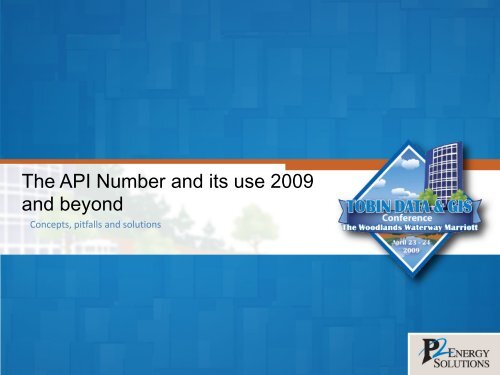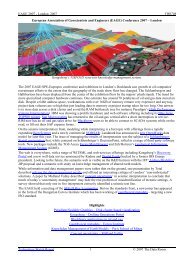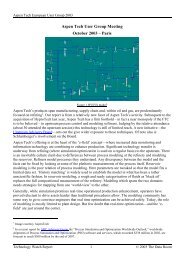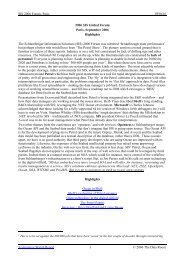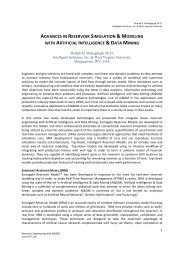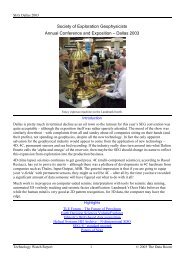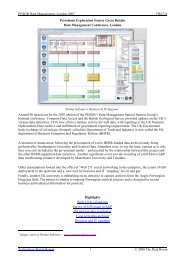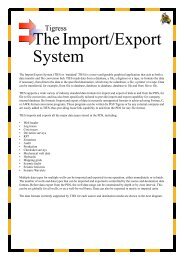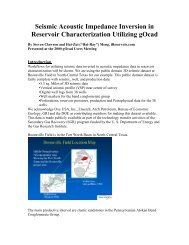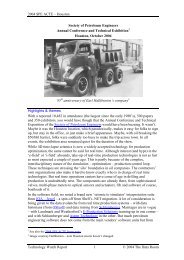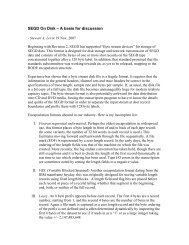The API Number and its use 2009 and Beyond - Oil Information ...
The API Number and its use 2009 and Beyond - Oil Information ...
The API Number and its use 2009 and Beyond - Oil Information ...
Create successful ePaper yourself
Turn your PDF publications into a flip-book with our unique Google optimized e-Paper software.
<strong>The</strong> <strong>API</strong> <strong>Number</strong> <strong>and</strong> <strong>its</strong> <strong>use</strong> <strong>2009</strong><strong>and</strong> beyondConcepts, pitfalls <strong>and</strong> solutions
Where are we now? :Current industrystate of well data integration in the U.S.All operators experience negative impact, whetherthey recognize it or not, with the currentindustry state of our available well headers.• <strong>The</strong> majority of companies <strong>use</strong> <strong>and</strong> rely in the <strong>API</strong> numberas the prime integration vehicle• Data integration is far from perfect– what each operator would like, or need• It is not completely broken or unusable
WHAT IS THERELEVANCE OF THE<strong>API</strong> NUMBER?In the U.S., the <strong>API</strong> <strong>Number</strong>is a (the) unique referencenumber (UWI) foridentifying wells.It is <strong>use</strong>d to link /integrateall forms of well datafrom vendors,government agencies<strong>and</strong> other operatorsInconsistent usage of the <strong>API</strong> numberbetween different sources will ca<strong>use</strong> dataintegration errors
<strong>The</strong> <strong>API</strong> <strong>Number</strong> as a link toother dataTwo examples of other reference numbers<strong>and</strong> (how easy it is) to attachincorrect attributesto the reference numberSocial Security numbersBank Account numbers
<strong>The</strong> <strong>API</strong> <strong>Number</strong>‐A bit of history1) Originally conceived in 1962(<strong>API</strong> Comm. Well DataRetrieval)2) About 7 years after Petroleum <strong>Information</strong> startedcollectingWell information.3) <strong>API</strong> st<strong>and</strong>ard first published 19664) Publication called the D12A in 1968 (added state/ctycodes)5) Revised in 1970, 1974 (added offshore st/co codes)<strong>and</strong> most recently in 1979 (more offshore areas)6) 29 years <strong>and</strong> no further published updates. Anunpublished update exists from about 1995. Nothingin the current edition covers horizontal drillingconcepts.
<strong>The</strong> <strong>API</strong> <strong>Number</strong>‐ Rest of the story1) Originally conceived in 1962(<strong>API</strong> Comm. Well Data Retrieval)2) About 7 years after Petroleum <strong>Information</strong> started collectingWell information.3) <strong>API</strong> st<strong>and</strong>ard first published 19664) Publication called the D12A in 1968 (added state/cty codes)5) Revised in 1970, 1974 (added offshore st/co codes)<strong>and</strong> most recently in 1979 (more offshore areas)6) 29 years <strong>and</strong> no further published updates. Anunpublished update exists from about 1995. Nothing in thecurrent edition covers horizontal drilling concepts.7) <strong>API</strong> does not want to continue support of <strong>API</strong> st<strong>and</strong>ard <strong>and</strong> itlooking for suggestions as to a subsequent sponsor<strong>The</strong> <strong>API</strong> <strong>Number</strong> continues to be a vital number to the O&Gindustry – currently in need of a champion for support.
Discussion SubjectsPart 1) <strong>API</strong> Basic Concepts ( then <strong>and</strong> now)Part 2) Differences in <strong>API</strong> numberassignments(between different sources) <strong>and</strong> theData Integration Problems that resultPart 3) Improving Data Integration Success– Solutions, Ideas <strong>and</strong> Suggestions.
<strong>The</strong> <strong>API</strong> <strong>Number</strong>• Part 1) <strong>API</strong> Basic Concepts, <strong>and</strong> Practices
<strong>The</strong> <strong>API</strong> <strong>Number</strong>‐Fundamental ConceptsIts Purpose“A need common of these organizations is asimple, consistent methods for identifyingall wells – an identity that will not changethrough time <strong>and</strong> an identity that will notchange with various well operations”(Page 5)
<strong>The</strong> <strong>API</strong> <strong>Number</strong>‐Fundamental ConceptsIts Purpose“It is imperative that each well (i.e. hole-inthe-ground)be uniquely identified in orderfor computer oriented data to be most<strong>use</strong>ful to industry, government <strong>and</strong>educational institutions” (Page 6, PP1)Had the first underlined word (each well, i.e. hole-in-the-ground)been implemented, a significant partof our <strong>API</strong> problems would have been overcome
Let’s diverge for a moment to consider ‘What is a well?’<strong>and</strong> what “ each well (hole-in-the-ground)” should meanBHLHardy <strong>Oil</strong> & GasBlackstone Minerals B-1Jefferson Co., TXTD 11656’ MD42245-32103-0000B-1500’ 500’Wellpath from P2ESdirectional surveyS.L.Surf. Loc.If a well is a defined as‘hole-in-the-ground’( <strong>and</strong> that implies weneed to knowthe well’s total depth),This shouldqualify as a well.
“D12A---It is imperative that each well (i.e. hole-in-the-ground) beuniquely identified… this well is actually composed of 4 ‘H-I-T-G’Hardy <strong>Oil</strong> & GasBlackstone Minerals B-1Jefferson Co., TX42245-32103-00002000’+/-Why then were the right3 wellpaths representing‘holes-in-the-ground’ignored aswells/wellbores?(only the left wellpathreceived a unique <strong>API</strong>number)( Part of this answer has to dowith historic collection practices)Are there any valid reasons not tocapture ‘each’ <strong>and</strong>all these wellbores? Can anyoneimagine an interpreter saying theydon’t want to see info onthese wells/wellbores
Surf.Loc.Hardy O&GBlackstone Min. B-1Jefferson Co., TX42245-32103-0000Today’s various G&Gapplicationswork better whenall wellbores arerecognized.Fundamental to maximizingthe <strong>use</strong> of their variousapplications is the ease& ability to associate justthe data that appliesto each, individual wellbore.
<strong>The</strong> <strong>API</strong> <strong>Number</strong>‐Fundamental ConceptsIts Purpose“… each well (i.e. hole-in-the-ground)be uniquely identified ……<strong>its</strong> sole purpose is to uniquely identify theIn every area we work we observe drilled that well. 15‐20%of the drilled wellbores were never uniquelyrecognized with <strong>API</strong>_12 numbers.This is one of the significant problems to successfuldata integration with the <strong>API</strong> number –missingwellbores make it very difficult.(there are solutions)
<strong>API</strong> <strong>Number</strong> Structure
<strong>The</strong> <strong>API</strong> <strong>Number</strong> Structure<strong>The</strong> <strong>API</strong> <strong>Number</strong> is a unique control number that representseach well /wellbore from the surface to total depth42 245 32103 00 00
How does the <strong>API</strong> number uniquely identify“ each well (hole-in-the-ground” ) <strong>API</strong> Parts 1 <strong>and</strong> 2BHLHardy <strong>Oil</strong> & GasBlackstone Minerals B-1Jefferson Co., TXTD 11656’ MD42245-32103-0000B-1500’ 500’42Houston1) State Code = 422) County Code=245S.L.Surf. Loc.<strong>The</strong> state/county codeis for the surface location
How does the <strong>API</strong> number uniquely identify“ ‘ each’ well (hole-in-the-ground” ) -- <strong>API</strong> Part 3BHLHardy <strong>Oil</strong> & GasBlackstone Minerals B-1Jefferson Co., TXTD 11656’ MD42245-32103-0000B-1500’ 500’S.L.Surf. Loc.42Houston1) State Code = 422) County Code=2453) Unique code=32103<strong>The</strong> unique code is aunique reference codewithin the respective county
<strong>The</strong> <strong>API</strong> <strong>Number</strong> Structure<strong>The</strong> Wellbore or Sidetrack code uniquely identifiesthe ‘children’ wellbore of the <strong>API</strong>_1042 245 32103 00 00
How does the <strong>API</strong> number uniquely identify“ ‘ each’ well (hole-in-the-ground” ) -- <strong>API</strong> Part 4-ST/WB Code’01’’00’Hardy <strong>Oil</strong> & GasBlackstone Minerals B-1Jefferson Co., TX42245-32103-00002000’+/-‘00’’03’’02’In a perfect world,<strong>API</strong> part 4 (char 11-12)would/could have beennumbered like this:OH 00ST1 01ST2 02ST3 03In this example only the deepestwellbore received an <strong>API</strong>_12 - the ’00’was assigned to the 11656’ TD wellbore
How does the <strong>API</strong> number uniquely identify“ ‘ each’ well (hole-in-the-ground” ) -- <strong>API</strong> Part 4-ST/WB Code’00’2000’+/-‘70’’02’This wasn’t a perfect world,<strong>and</strong> only 1 wellborereceived an <strong>API</strong>_12 withchar 11-12 assigned the ’00’Hardy <strong>Oil</strong> & GasBlackstone Minerals B-1Jefferson Co., TX42245-32103-0000What was accomplished?1) every wellbore got an <strong>API</strong>_12.2) <strong>The</strong> initial ’00’ was not changed’01’Using some numberingoptions, we (later) filledout the ST/WB codesfor each wellbore as:OH 70ST1 00 WB init. assignedST2 01 Could have been 71ST3 02 Could have been 72
A word on <strong>API</strong>_14 usage – Not a formal part of the <strong>API</strong> <strong>Number</strong>, but<strong>use</strong>d by part of the industry with characters 13-14 to uniquelydescribe operational sequences within a specific wellboreCharacters 13-14 shouldnot be <strong>use</strong>d to uniquelyidentify a wellbore.Hardy <strong>Oil</strong> & GasBlackstone Minerals B-1Jefferson Co., TX42245-32103-0000’0000’ WB OH TD-10000’‘0001’ ST TD – 11137’Where characters 13-14 are<strong>use</strong>d to reference welldeepenings, problems arecreated in the collapsing of<strong>API</strong>_14 to <strong>API</strong>_12 format –i.e. 2 well TDs existrequiring a slightly differentenhanced data model toaccommodate both, or justa loss of data.
Using the 70-series in the wellbore code
why not just re-number all the wellbores?1) Clients already using the ’00’ –it has been loaded to all sortsof interpretation projects2) Other forms of data hasalready been stored <strong>and</strong>/orlinked to this ’00’ in client DBs.3) Changing all of client DBs not asimple trickle down UWIchange for most.4) If the ’00’ had productionassociated with it – that <strong>API</strong>number is generally ‘sacred’ –can’t change.Original hole (pilot) WB1 ’70’Sidetrack 1 WB2 ’71’Bypass 1 after ST 1 WB3 ’72’Bypass 2 after ST 2 WB4 ’00’<strong>The</strong> best rule seems to be live with the existing assignedST/WB codes (char 11-12) <strong>and</strong> number around them’00’
Finally ‐‐<strong>The</strong> <strong>API</strong> <strong>Number</strong>‐an initial planIts Planned Purpose <strong>and</strong> where the planheaded South“<strong>The</strong> cooperative well data systems haveagreed to make the numbers on historicalwells available to state <strong>and</strong> federal regulatoryagencies <strong>and</strong> to the industry.”(Page 6, PP3)Had this truly happened, we would not havethe data integration problems that we see today.<strong>The</strong>re is a solution we will review later…
Geoscientists & engineers unknowingly gamble on a routine basisEverytime:1) they assume the datasets being<strong>use</strong>d, like velocity, paleo, logs,reservoir /core analyses,production <strong>and</strong> test information,etc. have been digitallyintegrated to the correct well /wellborePt 2) Differences in <strong>API</strong> numberAssignments (between differentsources) <strong>and</strong> the Data Integrationproblems that result
What happens when we integrate data from 4different wellbores to a DB with only 1 ?Data either gets ‘lumped’ or ‘lost (rejected). Where lumped, think ofthe interpretation confusion but we can now do it at lightspeedwith our applications
<strong>The</strong> basic data integrations problemsusing <strong>API</strong> numbers1) Different sources <strong>use</strong> the same <strong>API</strong>_12 to describe 2 or more different wells.(Problem is generally in characters 11-12, not in the parent <strong>API</strong>_10 number)TD becomes a key.2) Completely different <strong>API</strong>_12 <strong>use</strong>d by different sources.3) Missed wellbores -biggest problem is missed sidetracks,but some are beca<strong>use</strong> of no <strong>API</strong>_10)3) Multiple wellbores ( <strong>and</strong> data) are ‘lumped’ under 1 <strong>API</strong>_12.4) <strong>The</strong> wellbore / <strong>API</strong> inventory are not uniform in different DBs.19 Mar 2007 JMS
All wellbores are not recognized with an <strong>API</strong>( ‘Missed wellbores’)Sea LevelEugene Isl<strong>and</strong> blk. 215 C-617709-40172-****<strong>The</strong> red dashedwellbores did nothistorically receive<strong>API</strong> numberassignmentsfrom the MMS.’00’OH( WB1)TD 12253ST1(WB2)TD10858 ST2(WB3)TD11158’01’ST3(WB4)TD 9703’02’ ’03’ ’04’’74’’73’ MMSMMSST3BP1(WB5)TD 10824ST4(WB6)TD11976ST4BP1(WB7)TD 11606How can you integratelogs, paleo, etc.to a wellbore thatdoesn’t have a UWIor any header data?
Data Integration By Pure <strong>API</strong>_12 Linking(Any differences ca<strong>use</strong> integration problems)<strong>API</strong> 60817-40878-(Year 2000 example)MMSScouts ( OOSA)Name / <strong>API</strong> code (dig<strong>its</strong> 11,12) <strong>API</strong> code / name6 OH “00” “00” 6 OH6 ST01 “01” “01” 6 ST6 ST01BP01 “02” “01” 6 ST6 ST02 “03” “02” 6 ST26 ST02BP01 “04” “02” 6 ST26 ST02BP02 “05” “02” 6 ST26 ST03 “06” “03” 6 ST3(equivalent wellbores are opposite each other)Slide info provided by Faye Schubert / Shell orig. to MMS DMWGScouts <strong>and</strong> MMSeach recognize7 wellbores , butthe <strong>API</strong> numbersassignedare quite differentAs a result6 of the 7wellboreswouldintegrateincorrectlyto the Shell/ MMSheaders
Agenda items relative to improvingclient data integration efforts.1) How do clients integrate well data2) <strong>API</strong> numbers <strong>and</strong> some cardinal rules3) Specific procedures for reconciling wellheader differences <strong>and</strong> adding new wells.19 Mar 2007 JMS
Client well data integration effortsare generally accomplished using3 different methods.<strong>The</strong>se methods are:1) Integration through pure <strong>API</strong> number linking (KEY),2) Integration using the <strong>API</strong> number AND an attribute likethe well total depth ( TD)3) Integration through matching multiplewell header elements19 Mar 2007 JMS
Integration through header dataIntegration pitfalls through matching well header elements1) Variations in data fields that make data field matching difficultIs this well recognized as the same? (3 well names for the same well)Houston O&M Galveston Bay 125 #1 ST4Tenneco <strong>Oil</strong> State Lease 75462 #3 BPTenneco E&P Galveston Bay 8000’ Sd Unit # 52) Data fields that are not uniformly populated3) Wellbores recognized in one but not all databases.19 Mar 2007 JMS
Data integration via the <strong>API</strong> is themost commonly <strong>use</strong>d methodData integration via <strong>API</strong> numbersis easiest IF the industry well headersare in ‘sync’ on <strong>API</strong>_12s.
Statement of current <strong>API</strong> consistencybetween all industry vendors1) No definitive, easily accessible source is available2) Clients/operators may chose to <strong>use</strong> a ‘free’ <strong>API</strong> sourceeven though data vendor sources are out of sync.3) For given <strong>API</strong>_12 #s, the same wellbore is not beingdescribed.3) Many <strong>API</strong>_12s on important wellbores are missing –both <strong>API</strong> inventories are incomplete. Secondaryvendors may have well data on a well with no industryheader.
Reconciling well headers between P2ES& IHSE improves client data integrationCardinal Rule # 1:Each <strong>API</strong>_12 needs to be describingthe same wellbore to thesame (essential) total depth.19 Mar 2007 JMS
Reconciling well headers <strong>and</strong> <strong>its</strong>affect on producing wellsCardinal Rule # 2:<strong>API</strong>_12 numbers with associated productionvolumes are deemed ‘sacred’ <strong>and</strong> must notchange. (Refinement of the well TD <strong>and</strong> otherheader items may still be necessary.)19 Mar 2007 JMS
Well header enhancementCardinal Rule # 3:Missing wellbores from both datasets<strong>and</strong> their respective headers can <strong>and</strong> shouldbe recognized with new <strong>API</strong>_12s. Sidetrack /wellbore codes onshore can be assignedin the conventional 01, 02, 03 series orin some cases a ’70’ series.19 Mar 2007 JMS
Reconciling well headersCardinal Rule # 4:<strong>API</strong>_12s are first <strong>and</strong> foremost ‘a uniquereference number’. As a uniquereference, number changes to the <strong>API</strong>_10or _12 must be for extraordinary problems( particularly if both IHSE <strong>and</strong> P2ES already <strong>use</strong> this <strong>API</strong>, <strong>and</strong>/orit has been in the industry usage for any length of time).19 Mar 2007 JMS
Cases of <strong>API</strong> numbering<strong>and</strong> well header reconciliation(numerous cases exist, for sake oftime we will show just 2)19 Mar 2007 JMS
Well header reconciliation <strong>and</strong>addition of new wellbore examples• Case 1- Only 1 <strong>API</strong>_12 exists, <strong>and</strong> both IHSE <strong>and</strong> P2ES are describingthe same wellbore. Minor header field differences.• Case 2- Only 1 <strong>API</strong>_12 exists, both IHSE <strong>and</strong> P2ES agree on TD <strong>and</strong><strong>use</strong> the ‘00’ as the sidetrack code. An additional, unrecognized OH isfound to exist – <strong>use</strong> a ’70’ series ST/WB code.
Newfield Miami Corp #317023-22726-00Reconciling Case # 2Missing wells / wellboresA simple example2ST1ST1ST1TD 5900’ MDAt this depth the well is36.08’ S <strong>and</strong> 84.77’ WBoth IHSE <strong>and</strong> P2ES <strong>use</strong> the ‘0000’but no other <strong>API</strong>_12 or 14 exist
Newfield Miami Corp #317023-22726-00Reconciling Case # 2Missing wells / wellboresA simple exampleST1TD 5900’ MDAt this depth the well is36.08’ S <strong>and</strong> 84.77’ W<strong>The</strong>re is a cla<strong>use</strong> in the 1979 version ofthe D12A that states: “<strong>The</strong> directionalsidetrack identity does not apply toremedial sidetrack operations in whichportions of the hole are purposelydetoured around junk, redrill of ‘lost hole’,or straightening ‘key seats’ <strong>and</strong> ‘crookedholes’.(Pg. 9 - 2 nd to last paragraph)This statement has been misinterpreted tomean “only the final wellbore fulfilling apermit’ gets assigned a sidetrack code.
Newfield Miami Corp #317023-22726-00Case # 2 continuedCorrect wellpath schematicof the # 3 with OH <strong>and</strong> ST1KOP @ or below1340’ MD2022’ N. of SLBackTD 5900’ MDST1Orig. HOLEWB 1This WB has no official <strong>API</strong> #with a ST code .(Yet we have data logs <strong>and</strong> adirectional survey to TDof 10750’.)TD 10750
Newfield Miami Corp #317023-22726-00Case # 2 continuedRules <strong>and</strong> <strong>API</strong> h<strong>and</strong>lingwhere a wellbore is missingKOP @ or below1340’ MDOH 17023-22726-7000Cardinal Rules3 ( Important newwellbore addition)1. 2TD 5900’ MDExisting ‘0000’ST 17023-22726-00001( both IHSE & P2 <strong>use</strong> it)2 (<strong>API</strong> w / production)4 ( <strong>API</strong> since 1997)BackOrig. HOLEWB 1TD 10750
Well Header cases.• Case 1- Only 1 <strong>API</strong>_12 exists, <strong>and</strong> both IHSE <strong>and</strong> P2ES are describingthe same wellbore. Minor header field differences.• Case 2 - Only 1 <strong>API</strong>_12 exists, both IHSE <strong>and</strong> P2ES agree on TD butan unrecognized OH exists – <strong>use</strong> a ’70’ series ST/WB code.• Case 3 - Only 1 <strong>API</strong>_12 exists ( a ‘0000’) between IHSE <strong>and</strong> P2ES butwe are describing different wellbores – determine who has the earlierwellbore, accept it, <strong>and</strong> create a new <strong>API</strong> for subsequent WB.
Case 3 – 1 <strong>API</strong>_12 between IHSE & P2ES, but2 different wellbores described.A hypothetical example –similar to many in our DBs.Rules for reconciling:1) Whichever source has the earliestwellbore is accepted as the ‘0000’ (char 11-14)2) <strong>The</strong> subsequent wellbore needs a new <strong>API</strong>_12 or 14created, the ‘0100’ with a complete new header file.IHSE ‘0000’OH – 11,150<strong>The</strong> issue here is we need to get in ‘sync’describing the same wellbore with theexisting ‘0000’ – one of the companieswill end up changing to be in sync,<strong>and</strong> we’ll both end up adding inthe new ‘0100’P2ES ‘0000’ ‘0100’ST1 – 11333’
Case 4 – 2 <strong>API</strong>_12 between IHSE & P2ESA hypothetical example –similar to many in our DBs.Subcase 1 – we are both describing same2 wellbores in same sequence.H<strong>and</strong>le minor well headerdifferences as in Case 1‘0000’OH – 11,150‘0100’ST1 – 11333’
Reconciled headers areimportant to clientsKey issues are:1) Working together to have a common wellheader.2) Timely passing through corrections <strong>and</strong>additions.3) Searching, recognizing, <strong>and</strong> makingchanges to keep headers in ‘sync’.This effort is moving forward beca<strong>use</strong> of our directional surveyeffort in select project areas <strong>and</strong> the research effort required.No reconciling effort is happening outside of our directionalsurvey project areas – it needs to.
Discussion SubjectsPart 3) Improving the <strong>API</strong>/Data IntegrationProblems– Solutions, Ideas <strong>and</strong> Suggestions.
Discussion Subjects• Update current D12A for new technology –drilling <strong>and</strong> data management– St<strong>and</strong>ard is way out of date, needs to be updated.– Needs to be looked at with current data models inmind‐<strong>API</strong> situations that relate to multiple dataoccurrences.
2) Build State agency support• States Need to capture <strong>API</strong> numbers to an <strong>API</strong>_12not just an <strong>API</strong>_10. Need to get states to buy into thisimportant concept.• States need to identify every wellbore (threat ofextra paperwork)• States may have other areas where they need toconsistently <strong>use</strong> or administer <strong>API</strong> assignments (seeB. Smith talk)• Intelligent permitting‐access to <strong>API</strong> verification byservice companies
3) H<strong>and</strong>ling the <strong>API</strong> Problems• What is your level of data management paintolerance. Options:1)As a company, ignore the <strong>API</strong>/Data Integrationissue(interpreters are not complaining enough)2) Try <strong>and</strong> manage integration issues on yourvarious well datasets by yourself, by your owncompany-with each data load correct all the problem <strong>API</strong>#’s3)As an industry, develop an st<strong>and</strong>ard headerthrough an <strong>API</strong>’ clearingho<strong>use</strong>’ that all vendors canlink to.
An industry cooperative effort <strong>and</strong> why <strong>its</strong>hould work.<strong>The</strong>sis: <strong>The</strong> <strong>API</strong> number is but a vehicle to linkeach company’s real data assets.<strong>The</strong> real data assets for vendors are:Basic well header data including perforation <strong>and</strong> testdata,Log data, Location data, Core data, Production data,Velocity data, Paleo data, narrative daily drilling data,Pressure data, etc.<strong>The</strong> <strong>API</strong> number in <strong>and</strong> of <strong>its</strong>elf is not the data asset.
What data elements are needed for anindustry common well header?• Reconciled UWI / <strong>API</strong> – <strong>API</strong>_12s• Possible alias / aka UWIs• State <strong>and</strong> county ( actual, not from <strong>API</strong> #)• Operator – original• Lease name / number• Well Name• Well <strong>Number</strong>• Well suffix• Well TD• Spud date
Fixing the <strong>API</strong> ProblemsA2D /TGSDrillingInfoIHSE<strong>API</strong>Clearingho<strong>use</strong>VelocityvendorsP2ES /TobinEnergyGraphicsState /FederalAgencies<strong>The</strong> best wellinventories <strong>and</strong>improved wellattributes areobtained whenmultiple sourcesare utilized.<strong>The</strong> point of clearing-ho<strong>use</strong> is a sourcethat all vendors /agencies can drawfrom to maintainsome commonalityin header data.
Comfort <strong>and</strong> ease in the datamanagement storm.Immediately after the recent Hurricane Ike when all powerwas down ( think here no ATMs working, no gas stations working,stores closed, <strong>and</strong> heaven forbid – no fast food, no cell<strong>and</strong> telephone coverage, no TV, <strong>and</strong> worse- no AC(important to think here -- hot, humid, lots of grumbling…)for virtually every ho<strong>use</strong> in Houston…I checked on a family that while their electrical lines were out,<strong>and</strong> trees down all over their property, including one on the ho<strong>use</strong>they still had full AC, lights, <strong>and</strong> power to their ho<strong>use</strong>,<strong>and</strong> comfort <strong>and</strong> convenience.<strong>The</strong>y had planned for that occasionLikewise, the <strong>API</strong> issues we face are manageable with effort& planning. <strong>The</strong>se problems will not solve themselves…ever.How much pain, loss of preformance, <strong>and</strong> mistakesis your company <strong>and</strong> our industry willing to endure?


